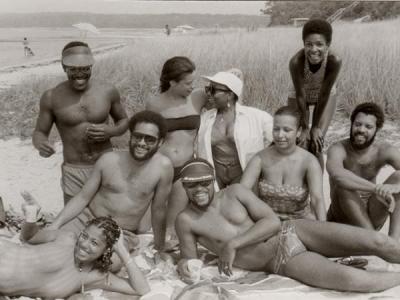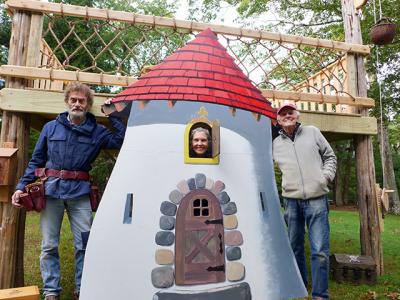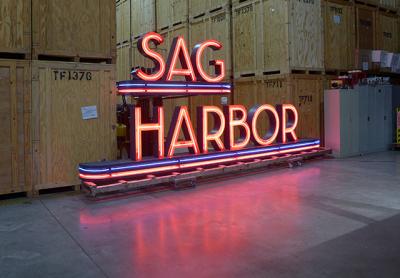Sag Harbor’s Black Summer Communities Press for Historic District
Sag Harbor’s Black Summer Communities Press for Historic District

When a resort subdivision designed by and for black Americans was laid out in the late 1940s in Sag Harbor, it was the first of its kind on eastern Long Island. Several similar developments followed on adjacent parcels of land. Now, owners of properties in the three neighborhoods seek historic district status, and were thrilled recently after receiving a statement of eligibility from state officials.
Residents of the three sections call their area SANS, for Sag Harbor Hills, Azurest, and Ninevah Subdivisions. A recently completed survey, commissioned by the group making a case for the landmark bid, was presented to an overflow crowd at the John Jermain Library in Sag Harbor on Friday.
“This is an opportunity to share the history of SANS, why it was important in American history,” said Renee V.H. Simons, the president of SANS Sag Harbor, a nonprofit seeking the historic district designation.
“It’s been a long project. It’s really hard to get through the stories without some tears,” she said.
This is not the neighborhoods’ first attempt to form a historic district. In 1990, when the initial Sag Harbor Historic District was being created by village officials, Sag Harbor Hills, Azurest, and Ninevah did not meet the 50-year eligibility requirement.
Allison J.M. McGovern, the survey’s principal author, speaking at Friday’s presentation, explained that the work involved assembling photographs, oral histories, ephemera such as a beloved annual calendar, and property records. In working with the material, Ms. McGovern said that important historical themes began to emerge.
Black resorts like these developed in the 20th century as a deliberate response to segregation and were rooted in the early civil rights movement, she said. Places like the Sag Harbor neighborhoods got a boost as post-World War II demand for getaways increased among blacks in a growing middle class and upper middle class. Property owners were lawyers, doctors, business owners, artists, academics.
In scope, the project was massive. There were seven subdivision maps, encompassing 162 acres in all. Some 306 houses would have to be surveyed and described in precise language in order to complete the historic district application. About 27 professionals from the National Organization of Minority Architects came to do the painstaking work during the first weekend of October.
Ms. McGovern noted that some other traditionally black parts of Sag Harbor were not within the survey area. These included Chatfield’s Hill and Hillcrest Terrace, which were left out, she said, because they did not meet state and federal historic district guidelines. “That doesn’t mean that they do not play a role. History exceeds the limit of that boundary,” Ms. McGovern said.
Sag Harbor’s earliest black community was centered around Eastville Avenue, beginning in the early 19th century, with the first documented people of African heritage living there around 1830. Many attended services at the Methodist Church before the A.M.E. Zion Church was built in 1839, which was at the heart of an integrated settlement that continued into the 20th century. Eastville was added to the Sag Harbor Historic District soon after its initial designation.
In the late 1800s, Ms. McGovern continued, Carrie Smiley, a seamstress with ties to Eastville, married T. Thomas Fortune, an economist and editor of the leading black newspaper of the time, The New York Age. He editorialized in favor of black resorts that would be separate from places where whites vacationed. This was an important antecedent for what would become Sag Harbor’s black neighborhoods.
Many of the older people interviewed in the survey said that the Ivy Cottage on Hampton Street, which served as an inn and offered a popular Sunday dinner, had been their first introduction to the area. Some Ivy Cottage guests eventually bought properties in the new subdivisions so they could come back year after year, first at Azurest, which was created by Maude Terry in 1947. Ms. Terry, a New York City schoolteacher, spent summers in Eastville with her grandchildren and fell in love with the woods and secluded beach — ideal, she thought, for a black summer colony.
Sag Harbor Hills followed in 1950 and Ninevah in 1952. Roads were named for family members, local black whalers, and old families such as the Cuffees.
At a time when banks were hesitant to lend money to blacks, mortgages could be secured from the developers. The Azurest Syndicate formed in 1953 to regulate the subdivision, maintain roads, and see to the neighborhood’s affairs, particularly a shared beach access for property owners alone. Dues were imposed for snow plowing.
News spread by word of mouth though New York City’s black communities. Would-be buyers frequently found out about this growing haven on the East End of Long Island through Jack and Jill, an organization created by black parents during the Great Depression to provide social and cultural opportunities for their children. Ms. McGovern said that the lack of overt marketing helped assure a sense of safety among the owners, many of whom knew each other year round through college connections and clubs.
For many, coming to Sag Harbor was roughing it; Eunice Vaughn, who was at Friday’s presentation, recalled that her first house there did not have hot water and that everyone shared a single bathroom. “Back in Harlem, we had four bathrooms, and all the hot water you could want,” she said.
There were many connections to the Harlem Renaissance. Famous figures such as Langston Hughes and Lena Horne came to visit, some to stay. Mostly, though, the property owners in SANS were entrepreneurs, businesspeople, educators, and administrators from the city.
Ms. McGovern noted that the developments contributed greatly to the Sag Harbor Village and East Hampton Town tax rolls (the neighborhoods are all within the town), adding that the residents’ spending came at a time when Sag Harbor was losing its industrial base but well before it became a summer resort.
Speaking during the presentation, John Brannen recalled walking into the business district with his friends to buy things at the 5 and 10. “Shopkeepers would say, ‘Thank you, sir.’ ”
It was for its inhabitants a place of comfort, safety, and community, deliberately laid out that way, Ms. McGovern said. “We felt safe not only in SANS, but on the streets of Sag Harbor,” someone in the audience put in.
Once its roads were paved, though, outsiders began moving in. Another audience member, Gwyned Sampson, described the sense of threat from the outside world in stark terms. On drives east with her family from their home in Queens in the 1960s, it was understood that they would not stop the car until they reached Riverhead. “We were safe within SANS,” she said. “Safety was in relation to the threat and hostility outside.”
Ed Dudley recalled first visiting the area in 1949, staying with cousins. A lot of Southerners, country people, liked to have a place they could go to swim and fish and not be bothered, he said. “Safety was very, very important.”
Ms. Simons said that residents were seeking home, seeking community. She herself could have lived anywhere after retiring from business management and marketing consulting, but she chose to be in Sag Harbor, she said.
The survey and landmark effort were done without support from Sag Harbor Village government, who declined to contribute to the work. A 51-percent threshold of residents would be needed for the designation to become official.






